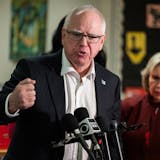The University of Minnesota hosted the NCAA track and field meet at Memorial Stadium in June 1948. Southern Cal, led by the great sprinter Mel Patton, was considered a cinch to take away the team title.
Fortune Gordien was a muscular young man from Minneapolis Roosevelt and a future world record-holder in the discus throw for 10 years. He won the discus and finished second in the shot put for the Gophers, and other points were found here and there, and late on the second day, it came down to the last event:
Now a staple as the triple jump, it was known as the "hop, step and jump" and was contested at the NCAAs only in Olympic years. It was so novel to Minnesotans that track expert Sid Hartman offered a two-paragraph primer on its components in the next day's Minneapolis Sunday Tribune.
This was necessary because Loyd LaMois, from Akeley, Minn., pointed toward the event by coach Jim Kelly, hopped, stepped and jumped 43 feet, 10 inches, to win the event and the NCAA championship for the Gophers.
"This was the first time I jumped from a board," LaMois said. "I tried the hop, step and jump for the first time in practice last week."
Of such resolve have been Gophers trackmen, before and for 72 years since, although not for much longer.
• • •
The acreage occupied by the University of Minnesota's track and field facility behind the Bierman Building was sacrificed for the massive Athletes Village that would cost $170 million, primarily to boost the football program.

![A black bear stopped after crossing Big Bay Road on Madeline Island, the largest of the Apostle Islands in Wisconsin, on Monday, May 31, 2021. ]](https://arc.stimg.co/startribunemedia/PWNYGIY3WTSWDBOGOYD775DPP4.jpg?&w=80&ar=1:1&fit=crop)

